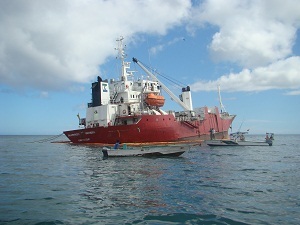A few days after the cargo ship Galapaface I ran aground on the rocks off San Cristóbal Island, Galápagos, high tides strengthened by a full moon rotated the ship some 40 degrees, further damaging its hull and worrying the people involved in the salvage effort, according to Dr. Arturo Izurieta, the Galápagos National Park Director. 
Galapaface I stuck on the rocks off San Cristóbal Island, Galápagos
Photo: Ecuadorian Environment Ministry
That was just one of several new challenges Dr. Izurieta spoke of Friday in a telephone interview with Galápagos Digital.
"Every day that comes along brings new things," Dr. Izurieta said, noting that he's gotten by with very little sleep in the two weeks since the ship ran aground.
On the positive side, Dr. Izurieta said there has been no evidence of contamination in the waters around the ship and that crews successfully removed 19,000 gallons of diesel fuel from the Galapaface I. He also praised the cooperation of the various agencies involved in the salvage effort as they deal with a whole gamut of issues. The crews working on the ship include not only Ecuadorians but specialists from several other countries.
"The ship now has big, big holes, " he said, noting that the largest one is 11 feet (3.5 meters) long.
That lessens the chances that the ship can be repaired successfully. According to Dr. Izurieta, the plan is to patch the hull temporarily, refloat the ship and tow it out of the Galápagos Marine Reserve where it can be scuttled, unless a buyer comes along to purchase the Galapaface I.
Dr. Izurieta described the mixture of seawater, rotting produce and toxic substances swirling about inside the ship's hull as a "contaminant soup," but noted that there has been no significant pollution detected in the waters nearby and that the ship will be pumped out once the holes are patched.
"So far, so good," Dr. Izurieta said, although he noted that lab results on samples of the ocean water in the vicinity of the ship have yet to be completed.
The salvage operators plan to import tons of equipment and repair supplies from abroad to patch and refloat the Galapaface I. Some items are awaiting customs clearance on the Ecuadorian mainland, despite a government-declared state of emergency. Asked whether anything was being done to cut through the red tape, Dr. Izurieta said "The President of Ecuador is aware of the situation," adding that the Environment Minister is doing everything possible to speed up the process.
Another headache for salvage crews: a generator they had hoped to use to power the ship's crane was not yet operating Friday afternoon. The generator had to be dismantled for shipping by plane from the Ecuadorian mainland and then reassembled at the site of the grounding in San Cristóbal. That work was going slowly, Dr. Izurietta said.
Once the generator is running and the crane can be operated, crews will be able to hoist some of the heavier items the Galapaface I was transporting, including a forklift truck.
As to whether officials can stick to their timetable of removing the Galapaface I within a month, Dr. Izurieta made no promises.
"Nothing is perfect," he said, "but we have managed to control the impact on the environment."
And how about lessons learned from this mishap? After the tanker Jessica ran aground off San Cristóbal in 2001, spilling 175,000 gallons of diesel and bunker fuel, investigators made a recommendation that tugboats be stationed in the archipelago to assist ships entering and leaving the populated islands. That recommendation was never followed and tugboats had to be dispatched from the mainland, 600 miles away, after the Galapaface I ran aground.
"We need to think seriously," about stationing tugs in Galápagos, Dr. Izurieta said, noting that each year brings at least four emergencies involving marine vessels nearby. He said he will push for the deployment of tugboats in the archipelago to provide a quicker response to future marine emergencies.
Dr. Izurieta holds a PhD in Rural Management and Natural Systems from the University of Queensland, Australia and has extensive experience in dealing with environmental issues. This is the second time he has served as Director of the Galápagos National Park.
George Lewis contributed to this story. You can read more about the Galapaface I on our blog, www.galapagosdigital.com
